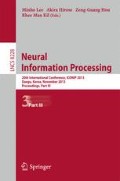Abstract
This work presents a new object-based visual attention model with bottom-up and top-down features. Bottom-up attention is related to the contrast of primitive visual features, such as color, orientation, and intensity. On the other hand, top-down attention is related to the intentions of the viewer and can be seen as a modulation process through the selection system. Thus, if the viewer is searching for an specific shape or color, the top-down modulation can bias the searching process in relation to those features. Our model is composed of five main modules which are responsible for the extraction of the visual features, image segmentation, object recognition, object-saliency map, and object selection. Results on natural images are compared with state-of-the-art approaches and an ground truth fixation maps for a variety of images revealing the efficacy of the proposed approach for visual attention.
Access this chapter
Tax calculation will be finalised at checkout
Purchases are for personal use only
Preview
Unable to display preview. Download preview PDF.
References
Achanta, R., Hemami, S., Estrada, F., Süsstrunk, S.: Frequency-tuned Salient Region Detection. In: IEEE CVPR, pp. 1597–1604 (2009)
Benicasa, A.X., Zhao, L., Romero, R.A.F.: Model of top-down / bottom-up visual attention for location of salient objects in specific domains. In: IEEE IJCNN (2012)
Benicasa, A.X., Quiles, M.G., Zhao, L., Romero, R.A.F.: An object-based visual selection model with bottom-up and top-down modulations. In: SBRN (2012)
Benicasa, A.X., Romero, R.A.F.: Localization of salient objects in scenes through visual attention. In: SBRN (2010)
Borji, A., Ahmadabadi, N.M., Araabi, B.N.: Cost-sensitive learning of top-down modulation for attentional control. MVA 22(1), 61–76 (2011)
Borji, A., Sihite, D.N., Itti, L.: Salient object detection: A benchmark. In: Fitzgibbon, A., Lazebnik, S., Perona, P., Sato, Y., Schmid, C. (eds.) ECCV 2012, Part II. LNCS, vol. 7573, pp. 414–429. Springer, Heidelberg (2012)
Bruce, N.D.B., Tsotsos, J.K.: Saliency, attention, and visual search: An information theoretic approach. Journal of Vision 9(3), 1–24 (2009)
Cheng, M., Zhang, G., Mitra, N.J., Huang, X., Hu, S.: Global contrast based salient region detection. In: IEEE CVPR, pp. 409–416 (2011)
Desimone, R., Duncan, J.: Neural mechanisms of selective visual attention. Annual Review of Neuroscience 18, 193–222 (1995)
Elazary, L., Itti, L.: A bayesian model for efficient visual search and recognition. Vision Research 50(14), 1338–1352 (2010)
Frintrop, S., Rome, E., Christensen, H.I.: Computational visual attention systems and their cognitive foundations: A survey. ACM TAP 7(1), 1–6 (2010)
Itti, L., Koch, C.: Computational modelling of visual attention. Nature Reviews Neuroscience 2, 194–203 (2001)
Judd, T., Durand, F., Torralba, A.: A benchmark of computational models of saliency to predict human fixations. MIT Computer Science and AI (2012)
Navalpakkam, V., Itti, L.: An integrated model of top-down and bottom-up attention for optimal object detection. In: IEEE CVPR (2006)
Quiles, M.G., Wang, D., Zhao, L., Romero, R.A.F., Huang, D.-S.: Selecting salient objects in real scenes: An oscillatory correlation model. Neural Networks 24(1), 54–64 (2011)
Silva, T.C., Zhao, L.: Network-based high level data classification. IEEE Transactions on Neural Networks 23, 954–970 (2012)
Walther, D., Koch, C.: Modeling attention to salient proto-objects. Neural Networks 19(9), 1395–1407 (2006)
Wang, D., Terman, D.: Image segmentation based on oscillatory correlation. Neural Computation 9, 805–836 (1997)
Wolfe, J.M., Horowitz, T.S.: What attributes guide the deployment of visual attention and how do they do it? Nature R. Neuroscience 5, 495–501 (2004)
Yantis, S.: Goal-directed and stimulus-driven determinants of attentional control, vol. 18, pp. 73–103. MIT Press, Cambridge (2000)
Author information
Authors and Affiliations
Editor information
Editors and Affiliations
Rights and permissions
Copyright information
© 2013 Springer-Verlag Berlin Heidelberg
About this paper
Cite this paper
Benicasa, A.X., Quiles, M.G., Zhao, L., Romero, R.A.F. (2013). Top-Down Biasing and Modulation for Object-Based Visual Attention. In: Lee, M., Hirose, A., Hou, ZG., Kil, R.M. (eds) Neural Information Processing. ICONIP 2013. Lecture Notes in Computer Science, vol 8228. Springer, Berlin, Heidelberg. https://doi.org/10.1007/978-3-642-42051-1_41
Download citation
DOI: https://doi.org/10.1007/978-3-642-42051-1_41
Publisher Name: Springer, Berlin, Heidelberg
Print ISBN: 978-3-642-42050-4
Online ISBN: 978-3-642-42051-1
eBook Packages: Computer ScienceComputer Science (R0)

